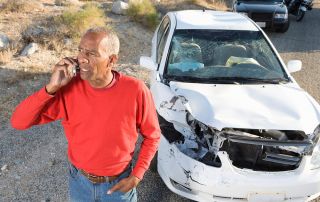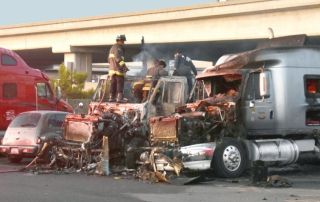
Hit and Run Accidents in Denver, Colorado
It is always a good idea to stay at the scene of an accident. Unfortunately, there are many reasons someone might leave the scene. A driver can be completely unaware that they were in an accident, or the emotion of the situation can cause a good person to make a poor decision. No matter the reason, it is important to know what to do in the case of a hit and run.

What is a Hit-and-Run?
An accident is defined as a hit-and-run if a driver involved in the accident leaves the accident scene before providing their information to the driver, occupant, or attendee of any impacted vehicle and, if applicable, providing assistance to any injured individuals.
The information includes the driver’s name and address, as well as the vehicle’s registration number. Upon request, the driver’s license can be included in this information. While not specified in §42-4-1603, it is a good idea to provide one’s insurance information as well.
When practical, the driver should also provide reasonable assistance to anyone injured. This includes carrying or arranging for the carrying of the injured to a physician, surgeon, or hospital if the need for medical service is apparent or requested by the injured person.
If no one involved in the crash is in a stable enough condition to receive the information, that information would be provided to the police. If no police are present, it is the driver’s responsibility to report the accident as quickly as possible and submit that information to them. It is not considered a hit-and-run if the driver fulfills as many of the above requirements as possible and then leaves the scene of the accident to report it. From there, the police might direct the driver to return and remain at the scene of the accident until the investigation has been completed.
In Colorado, parking lot collisions can also be considered hit-and-run. Backing into an unoccupied car and failing to attempt to locate the vehicle’s driver or leaving a note with a name, address, and vehicle registration number on the windshield or another conspicuous place will be considered a hit-and-run accident. The driver must also report the accident to the police, or a traffic violation will be committed.
Similarly, hitting and damaging property that is not a vehicle can still be considered a hit and run if the owner is not notified directly or by a securely attached note containing one’s name, address, and registration number of the vehicle one was driving. This type of accident must also be reported to the police so the driver does not incur a traffic violation.
Penalties for a Hit and Run in Colorado
The penalties for a hit-and-run accident depend on whether the accident resulted in injury, serious bodily injury, or death of any person.
- An injury to any person = Class 1 misdemeanor traffic offense.
- Serious bodily injury to any person = Class 4 felony.
- Death of any person = Class 3 felony.
- No injuries, or unattended vehicle or property = Class 2 misdemeanor traffic offense.
A person convicted of leaving the scene of the accident will also have their driver’s license revoked and 12 points added to their Colorado driving record.

What To Do If You Are In a Hit and Run
Victims of hit-and-run accidents are unfortunately at higher risk for worse injuries or even death because they are left without aid. In addition, they cannot file an insurance claim against the other driver because they do not have their name, address, vehicle registration, or insurance information.
If you have been in a hit-and-run accident, here’s what to do to mitigate risks:
- Call the police: The responding officers will manage the scene to prevent further injuries or deaths, call ambulances if necessary, and investigate the collision. They will also ask you some questions as part of their investigation and prepare an incident report.
- Request any necessary medical attention: Tell the police if you know you need emergency medical care. The paramedics who arrive will do screenings and administer first aid.
- Determine if you need transportation to a hospital: If your injuries prevent you from leaving the scene without aid, the ambulance can take you to the emergency room. If you can get a ride or drive yourself without endangering your health, you can also choose to drive yourself.
- Regardless of how you seek it, you should see a doctor after your accident. In addition to getting the medical assistance you deserve, the medical records relating to your injury will be critical for an insurance claim or lawsuit.
- After addressing your health, now it’s time to review your auto insurance policy. Your policy may have optional coverages that could apply to your hit-and-run accident, such as collision, medical payments (MedPay), or uninsured motorist.
Contact a trustworthy personal injury lawyer: At Shafner Law, we have the expertise and experience to assist you in filing your insurance claim or lawsuit. If the at-fault driver is identified, then we can help you take legal action against them and earn the just compensation you deserve. If the at-fault driver is not identified, then we can still negotiate with your insurer to secure fair compensation on your behalf.
How an Experienced Hit and Run Accident Attorney Can Help You
For a free consultation with our personal injury attorneys, call Shafner Law at (303) 796-0555 or fill out the Case Form below.







